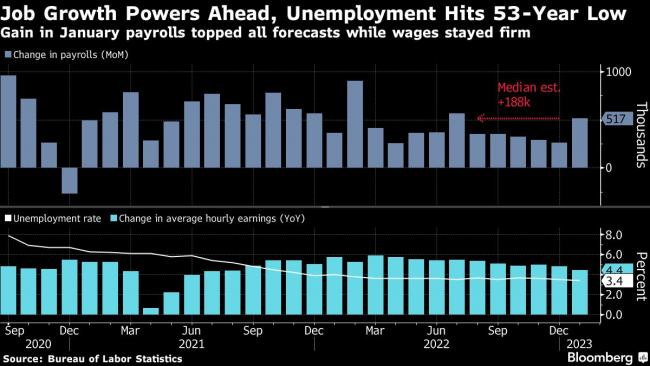(Bloomberg) -- Economists are scratching their heads as to whether the US labor market is truly as strong as the latest employment report indicates or if wonky adjustments are getting in the way.
Employers added 517,000 jobs in January — nearly double the prior month’s advance and above all estimates in a Bloomberg survey. The unemployment rate also unexpectedly retreated to 3.4%, the lowest since 1969, according to Labor Department data released Friday.
Forecasters can at least agree on this much: the jobs market has shown few signs of falling victim to the Federal Reserve’s most aggressive interest-rate hiking campaign in a generation.
But the employment report was complicated by the government’s annual benchmarking process, as well as an update of seasonal adjustment factors and population controls that economists indicated before the release could make the data difficult to interpret.
“Seasonal adjustment factors appear to have flattered the headline as smaller-than-usual post-holiday layoffs bolstered the payrolls numbers,” Wells Fargo (NYSE:WFC) & Co. economists Sarah House and Michael Pugliese said in a note.
“We suspect members of the FOMC will take January’s blowout employment report with somewhat of a grain of salt,” they said, referring to the Federal Open Market Committee that sets monetary policy.
What Bloomberg Economics Says...
“If it seems too good to be true, that’s because it is too good to be true — the gain is mostly due to seasonal factors and revisions to past data. Still, it can’t be denied that the labor market remains tight. The Fed won’t place too much weight on this headline jobs number when formulating policy.”
— Anna Wong and Eliza Winger, economists
To read the full note, click here
The jobs report is composed of two surveys, one of households and the other of businesses. Each were affected by the Labor Department’s yearly fine-tuning process designed to paint a more accurate picture of the job market.
The release included an annual update to the population controls used in the household survey, which tracks the unemployment and participation rates, as well as the employment-to-population ratio. The adjustment boosted the estimated population size by nearly 1 million and the civilian labor force by 871,000.
For the establishment survey, the government’s updated seasonal factors may have impacted the headline payrolls figure. On an unadjusted basis, payrolls actually fell by 2.5 million last month.
The Labor Department also reclassified about 10% of employment into different industries in accordance with an update to the North American Industry Classification System. That resulted in “major revisions” to sectors like retail trade and information, as well as “minor” ones within industries like manufacturing and financial services, according to the report.
What’s more, the yearly update to the establishment survey showed job growth was revised higher for the final six months of 2022.
“Revisions due to both the NAICS 2022 conversion and the benchmark process affected more historical data than typical in the annual benchmark process,” the Labor Department said in the report.
Others aren’t so convinced that the revisions played much of a role. The 2.5 million decline in unadjusted payrolls was the smallest for January since 1995 — significant for a month that’s typically weak due to laying off holiday workers.
“We can’t completely dismiss all of these data. We can’t blame it on the seasonals,” said Jennifer Lee, senior economist at BMO Capital Markets. “Breaking it down by industry, it’s pretty safe to say there’s wall-to-wall strength.”
Omair Sharif, president of Inflation Insights LLC, noted that could reflect labor hoarding, which economists say may be contributing to job market resilience because employers are desperate to hold onto staff that they worked so hard to hire in the last few years. That was most evident in the health, leisure and construction sectors, he said.
‘Clean Read’
“I think we can rule out seasonal adjustment and the response rate as possible sources of distortion in the data,” Sharif said in a note. “For the most part, the payrolls data looks like a pretty clean read.”
It’s tough to say how the Fed will view the data. As much as policymakers would probably want to discount the strength in the labor market — which they see as one of the last hurdles to taming inflation — other indicators like a surge in job openings and historically low unemployment claims show demand for workers is broadly intact and greatly exceeds supply.
“It seems reasonable to expect a correction in payroll growth in February, but the labor market nonetheless is going to look tight when the Fed sits down in March,” Ian Shepherdson, chief economist at Pantheon Macroeconomics, said in a note. “The Fed thinks the labor market is too tight, and the latest payroll and unemployment data do not change that picture.”
